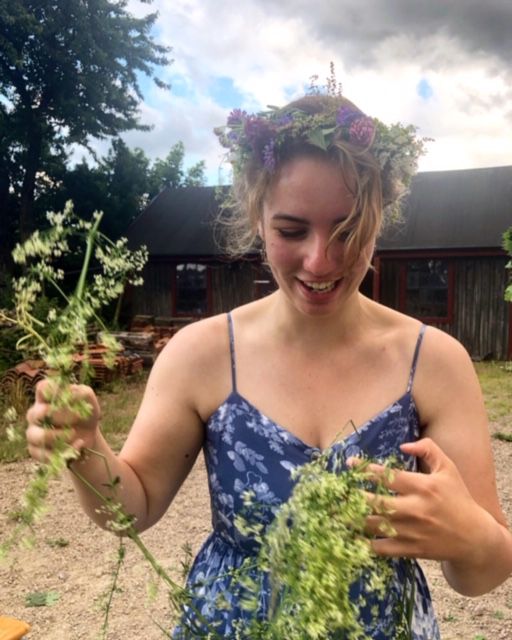Some information may be outdated.
There is a warm, welcoming feeling as Sweden turns to summer. In the morning, I wake up to birds singing, and biking to and from the bus stops, I no longer need a jacket. It’s a slow but steady introduction to the last chapter of my exchange here.
School has finally ended. It wasn’t until the very last days, with many of my classes canceled for celebration, did I realize how very little time I had left. The end of school comes with Studenten, otherwise known as graduation. For the last week of school, all the graduating students can be seen around the city dressing up for various gatherings. One of these events includes dressing up to a theme — much like homecoming week back home. They also have prom, filled with lots of champagne and dancing, which is then followed with the last day of graduation, where everyone wears white dresses and nice suits with sailor caps. Parents come to take photos as their children ride around the city on huge trucks to scream “Vi har togit studenten!” (We have graduated!). It should be noted however, I was not able to do any of these activities, as I was placed in the first class year in my school, and my class takes studenten in two years.
When I first came to my current host family in January, my host mother told me “It may be cold and terrible right now, but just wait until summer.” And she was right. The flowers in the garden have sprung up, and the grass seems to never stop growing. I have taken to watercoloring and sunbathing in the garden during my free days, but as the days start leading up to Midsommar, there has been lots of work to make it even lovelier. Gardening has been my favorite part of my stay, as I learn the different names for flowers, and being given the time to just enjoy.
Midsommar is a celebration which takes place on the summer solstice to celebrate fertility into the land. Although my host dad likes to call it a “hedonistic holiday,” it is all good fun. On Midsommar, you start your day first by picking strawberries from the fields, although more than often, you’ll find yourself eating more than gathering. When you have taken your bounty, you bring it home to be sliced for jordgubbstårta (special Swedish strawberry cake).
The traditional dress for Sweden isn’t used very often anymore, so instead many will wear white, or substitute the whiteness for flowery summer dresses to a Midsommar day. Shoes optional.
With masses of family and friends at every side, it’s good to get to work or you feel left out. One of the best jobs is gathering greenery from the local leaves and trees, so as to decorate the maypole. The maypole can be a long or short stand much like a cross, which has two wreathes under the sides. The only way to explain its symbolism is that of a reproductive organ — which is again fertility in the Earth. There is no end to flowers on the Swedish countryside; yellow, blue, purple and white; picking them transports you to the feeling of being a faraway maiden within the stories your parents would tell you as a child.
This greenery is good for both the maypole as well as the flower crowns which are worn by every member of the Midsommar party (no exceptions to masculinity). Making your own crown is a heartfelt event, as you pick the flowers you feel represent you in the best way you can. For me, I had many purple flowers with greenery.
Once the decorating and such is finished, it is time to dance around the maypole. First, you must form a circle around the maypole, holding hands with the people next to you, and as someone starts to sing, you start jumping with the group around the maypole, singing without knowing the words and dancing without knowing the steps. It’s all good fun. There is one special song, which must be sung around the maypole: “The Frog Song.” While you sing The Frog Song you must jump around the maypole as though you are a frog, which takes more skill than you would imagine.
In Sweden, they have a word to describe the feeling of joy and comfort in moderation: “lagom” (pronounced laaaw-gum). It is during these moments of silly dancing like a frog, and peace with your own foolishness and happiness, that lagom can be found.
Once the dancing and singing is finished (although in reality it never is), prepared food is brought out to eat until you burst. Plates of smoked salmon and pickled herring are tastefully eaten with sour cream or mustard. Potatoes and roasted vegetables also fill the table. All continue singing drinking songs, with a good beer or schnapps in hand (or apple juice in my case), only to be full and drunk by the end of the night. But it’s not over yet.
There is a little legend: if a young woman were to pick several different wildflowers and put them underneath her pillow as she sleeps, she will dream of her future husband. It’s a whimsical and romantic thought to Midsommar — if the Earth can be full and fertile, so can our future.
Midsommar was the best way to end my exchange year to Sweden. Surrounded by family and friends I loved, and learning about a holiday (a pagan one) that is so widely celebrated here, and nowhere else. It not only excites me for the future I have but the possibility of returning to Sweden so that I may experience these holidays and celebrations again.
Thank you again to the wonderful Moab community that made it possible for me to come here and experience the freedom and joy of starting in a new country, and learning as much as I have learned.
Emma Millis is a local 16-year-old high school student who decided to go to Sweden for the 2018-19 school year with AFS Intercultural Studies.
Appreciate the coverage? Help keep local news alive.
Chip in to support the Moab Sun News.



